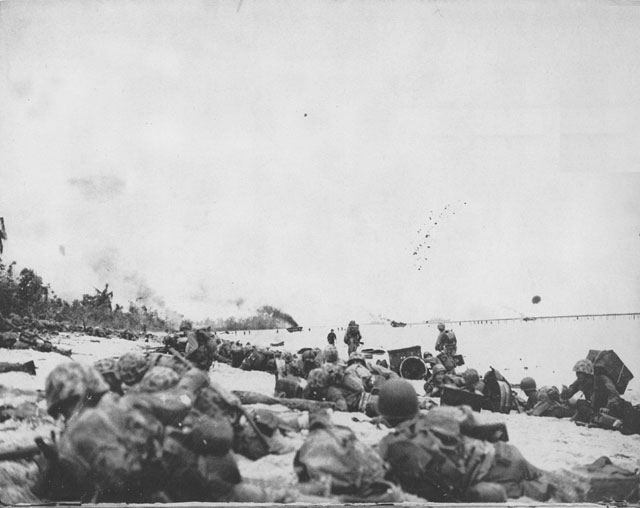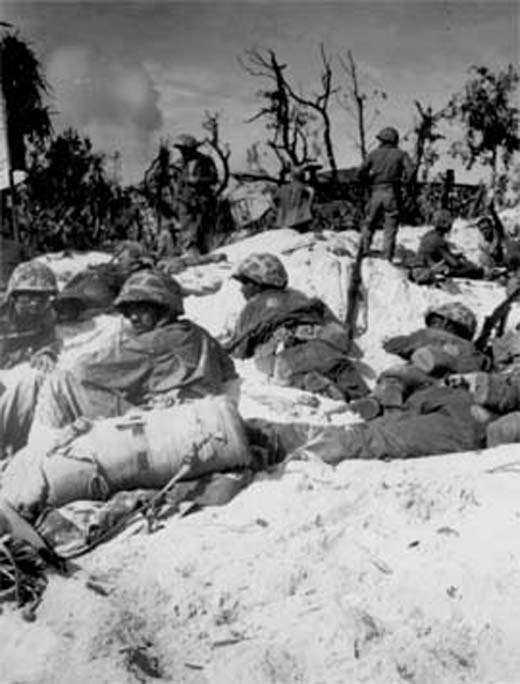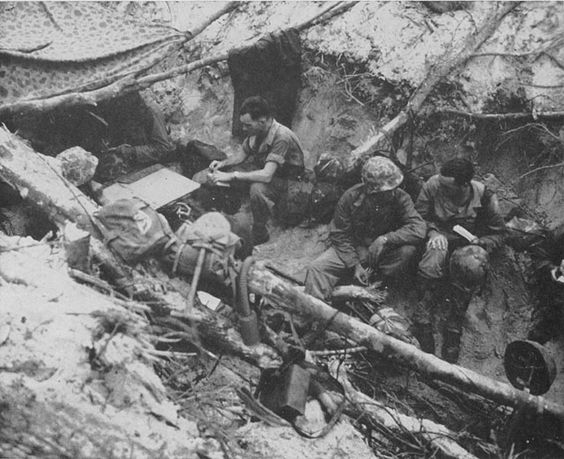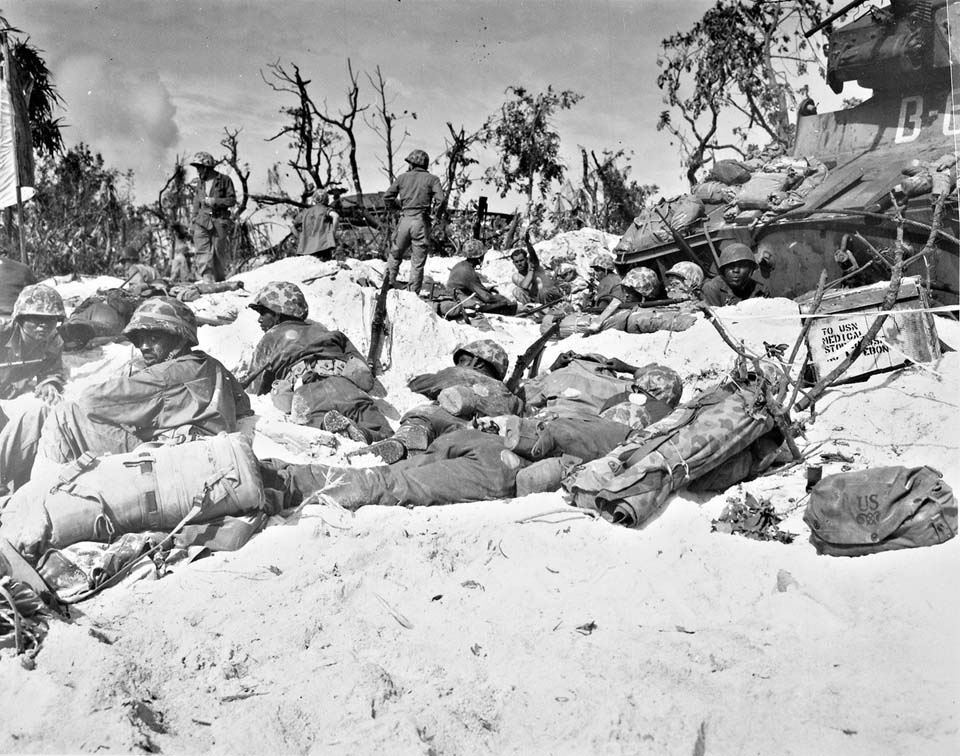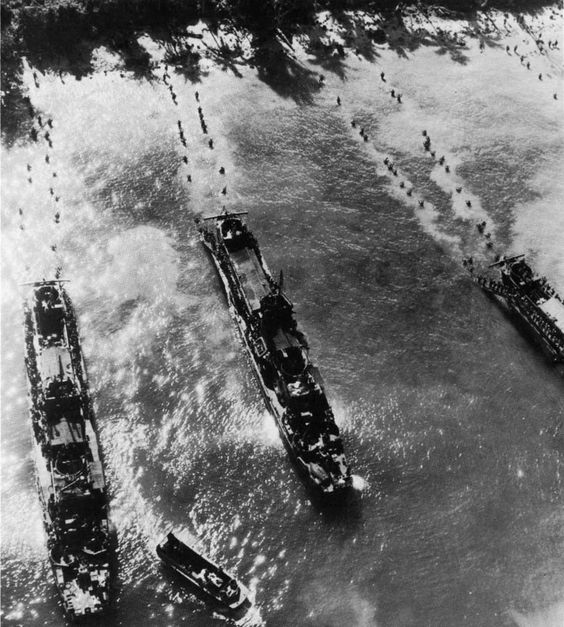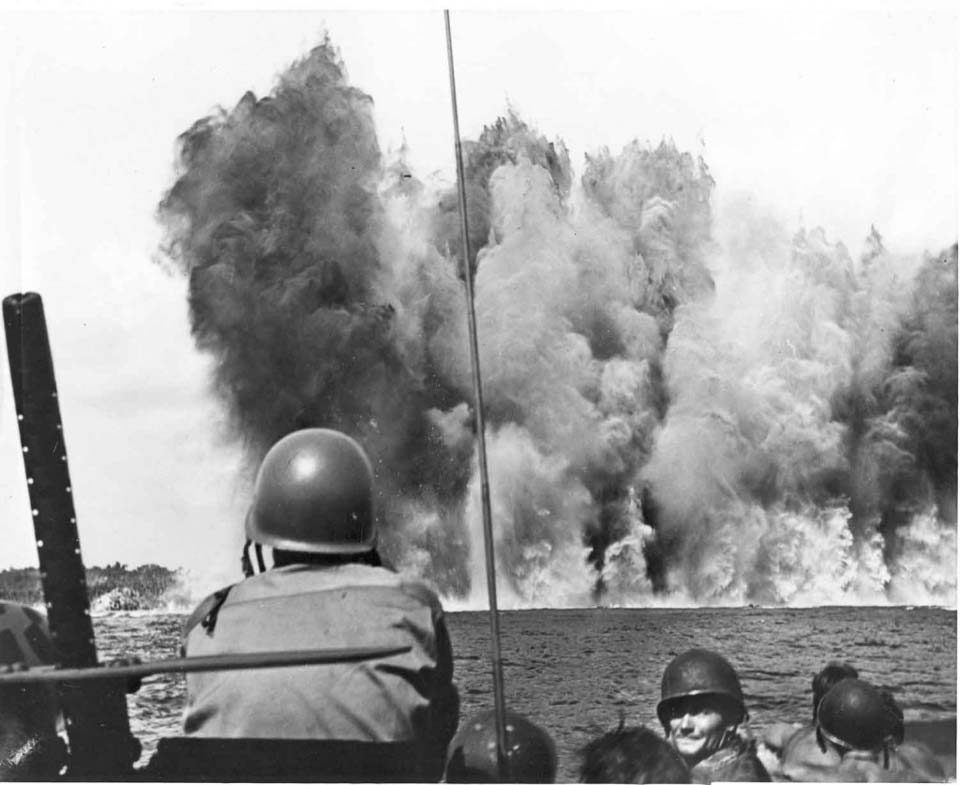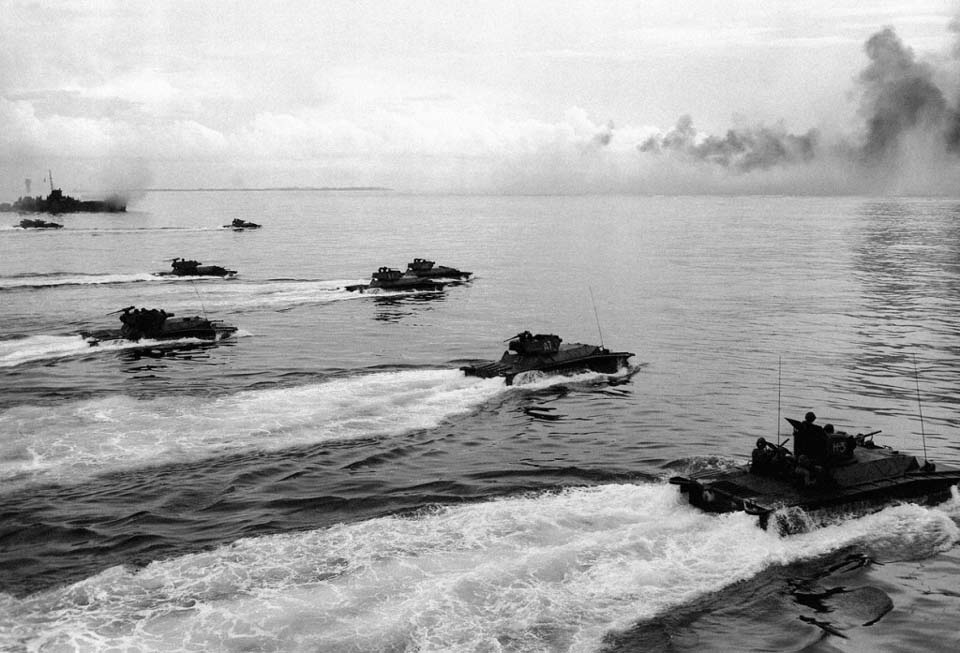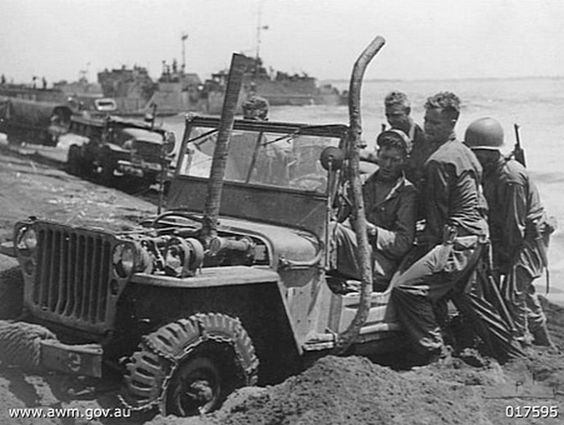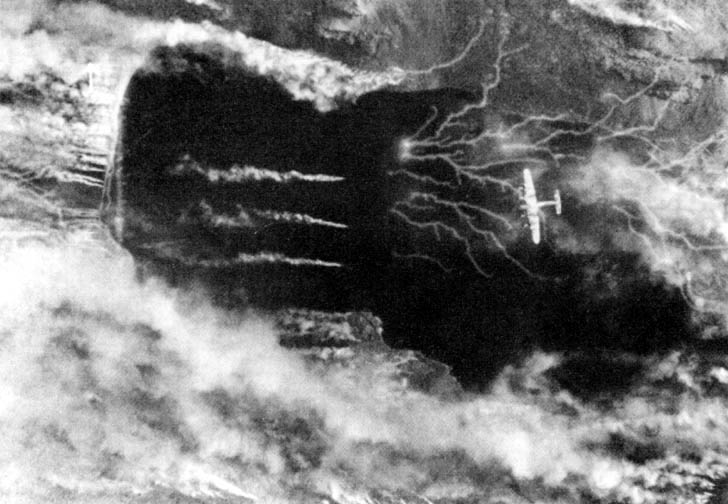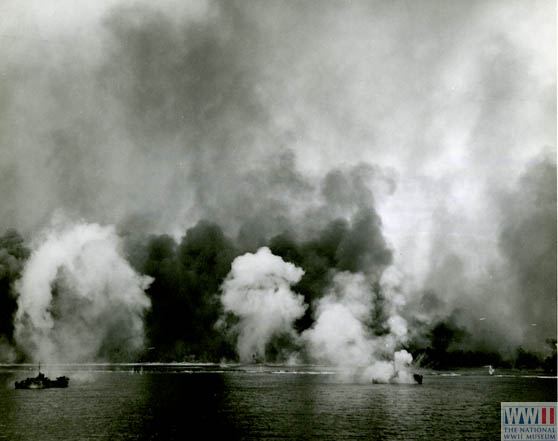Air Operations, Carolines
- The 1st US Marine Division lands at Peleliu Island against heavy opposition. Air cover is provided by Task Group 38.4 and the escort carriers of Task Group 32.7.
- At the last minute, before Marines arrive ashore, 48 FMs (12 each from VC-20, VC-21, VC-27, and VC-75) strafe the landing beaches and areas immediately to the rear. Later in the day, escort-carrier aircraft help Marines beat off a counterattack by IJA tanks.
- Advance headquarters detachments of the 2nd Marine Aircraft Wing and Marine Air Group 11 land with the invasion force. They will oversee Marine air operations undertaken in support of the Palaus Campaign.
Air Operations, CBI
BURMA- 16 10th Air Force P-47s sweep the Irrawaddy River between Bhamo and Katha.
- 12 P-51s attack Mawhun.
- 8 P-47s attack Kutkai.
- Several P-47s sweep the Burma Road from eastern Burma to Lungling (China).
- 19 308th Heavy Bomb Group B-24s attack military stores at Hengyang.
- 20 341st Medium Bomb Group B-25s attack Chuanhsien.
- 5 B-25s attack Lingling.
- More than 90 14th Air Force fighter-bombers attack Changsha, Kiyang, and wide surrounding areas.
- 8 10th Air Force B-25s attack fuel stores and targets of opportunity in the Chefang area.
- 13 7th Heavy Bomb Group B-24s transport fuel from India to Liuchow, China.
Air Operations, East Indies
- US Army ground troops land on Morotai Island against negligble opposition. The Pitoe airfield there is quickly captured.
- In support of the invasion of Morotai, US aircraft from Task Group 38.1 and 7th fleet escort carriers attack targets on Halmahera, Batjan, and Celebes islands. US surface warships also attack areas of Halmahera.
- FEAF B-24s, V Bomber Command A-20s, and V Fighter Command P-47s attack the airfield at Hate Tabako, the Kaoe and Lolobata airfields on Halmahera while 2 38th Medium Bomb Group B-25s spray insecticide over Morotai.
- A VF-2 F6F downs a G4M 'Betty' bomber 30 miles from the US carriers at 1220 hours.
Air Operations, Europe
RAF BOMBER COMMANDDaylight Ops:
- 38 Lancasters of Nos. 9 and 617 Squadrons and a No. 5 Group Mosquito for weather reconnaissance had set out on September 11 to fly to Northern Russia in preparation for this raid on the 45,000-ton battleship Tirpitz, which is at anchor in Kaa Fjord in Northern Norway. 1 aircraft returns to Britain and 6 crash-land in Russia but their crew members are not seriously hurt. Only 27 Lancasters and a further Lancaster with a cameraman on board are available for the raid on the Tirpitz, which eventually takes place this day. 20 aircraft are loaded with the 12,000-pound Tallboy bomb and 6 (or 7, the records are not clear) carry several 'Johnny Walker' mines - of 400-500-pound weight developed for attacking capital ships moored in shallow water. The attack catches the Tirpitz by surprise and her smoke-screens are late in starting. One Tallboy hits the Tirpitz near the bow and causes considerable damage. The shock caused by the explosion of this bomb, or possibly from other bombs which are near misses, also damage the battleship's engines. The Germans decide that repairs to make Tirpitz fully seaworthy are not practicable and she will be later moved to an anchorage further south in Norway, but only for use as a semi-static heavy artillery battery. These results of the raid are not known in England at the time and further raids against Tirpitz will take place.
- None of the Lancasters are shot down on the raid and all return safely to the airfield in Russia but the No. 617 Squadron aircraft of Flying Officer F. Levy crashes in Norway while returning to Lossiemouth 2 days later with 11 men on board.
- There are 9 RCM sorties and 1 aircraft on a Resistance operation.
- There are no losses.
- 490 aircraft are sent to Kiel. In this total are 310 Lancasters, 173 Halifaxes and 7 Mosquitos of Nos. 1, 4, 6 and 8 Groups. The evidence of returning crews and of photographs cause Bomber Command to record this as 'a highly concentrated raid' with 'the old town and modern shopping center devastated'.
- 4 Halifaxes and 2 Lancasters are lost.
- Support and 164 aircraft make a diversionary sweep over the North Sea, 27 Mosquitos are sent to Berlin, 9 to Lübeck and 8 to Rheine airfield, 68 Halifaxes and Lancasters lay mines near Oslo, the Kattegat and in the Elbe River, and there are 56 Mosquito patrols and 34 RCM sorties.
- 4 Mosquitos and 1 Stirling are lost on the operations.
GREECE:
- 15th Air Force B-24s attack marshalling yards at Athens.
- In an effort to halt or stall the evacuation of German Army troops and materiel by air, B-24s attack the Athens/Eleusis and Athens/Tatoi Airdromes.
- B-17s attack the Athens/Kalamaki Airdrome and the submarine base at Salamis.
- 24 15th Air Force B-24s transport USAAF aircrewmen formerly imprisoned in Bulgaria to Bari, Ital, from their repatriation point in Cairo, Egypt.
Air Operations, New Guinea
V Fighter Command P-39s attack Manokwari and the airfield there.
[Allied Planning
Roosevelt and Churchill approve the Morgenthau Plan. Henry Morgenthau is the US Secretary of the Treasury, and his ideas have gained increasing influence in the administration over the past year. Morgenthau believes that the War Department's plan for postwar occupation of Germany is too gentle. His plan divides Germany into two sections, north and south, and dismantles completely her industrial capacity, reducing the states to basic subsistence agriculture. There will be no aid or support to Germany whatsoever. The Soviet Union will most of Germany's dismantled industry as reparations. Although the plans is strongly opposed by many advisers, it remains the unofficiao Allied plan until the Potsdam Conference of 1945. The Morgenthau Plan, coupled with the demand for unconditional surrender, is a propaganda coup for Hitler. Germany's defeat meant the complete destruction of the nation and the subjugation of the German people. Despite wsvering in Hitler, Germnan national morale rallies.
President Roosevelt relents in his insistence on US forces occupying northwest Germany after the war. He agrees to US forces occupying southwest Germany and the division of Berlin into zones of occupation.
[Battle of the Atlantic
It is not known when or how U-743 is lost. It is presumed to have been a victim of a mine or an accident during the middle of September 1944.
| Class | Type VIIC |
| CO | Oberleutnant zur See Helmut Kandzior |
| Location | N Atlantic, NW of Ireland |
| Cause | Unknown |
| Casualties | 50 |
| Survivors | None |
Burma-China
Chiang Kai-shek threatens to withdraw his troops from the Salween if the Chinese and American forces in the Myitkyina sector do not carry out an offensive to the south within a week.
In Burma, in the British XXXIII Corps sector, the 5th Indian Div continues its advance on Tiddim, establishing a bridgehead across the Manipur River near Tuitum.
[CBI
A Combat Cargo Task Force is formed within Eastern Air Command, under Brig-Gen Frederick W. Evans, to support the British 14th Army's offensive into southern Burma.
[Eastern Front
The German South Ukraine Group succeeds in concentrating 27 divisions and brigades, including 6 armored divisions, before Cluj in Transylvania. These forces block the advance of the 2nd Ukraine Front. The Polish 1st Army of the 1st Belorussian Front begins crossing the Vistula from Praga to Warsaw.
FINNISH SECTORThe German 20th Mountain Army launches an abortive attack against the port of Suursaari, prompting the Finnish Government to demand its immediate withdrawal from the country.
NORTHERN SECTORThe Germans put up stout resistance against the Soviet 1st Shock Army near Valk and the 3rd Shock, 10th Guards and 22nd Armies near Madona.[MORE]
[France, Politics
François de Menthon, the Justice Commissioner, orders the arrest of Marshal Pétain and all the members of the Vichy Cabinet because of their alleged collaboration with the Germans.
[Greece
Between September 12 and 15 the Germans evacuate Mitilini and the Ionian Islands.
[Italy
8th Army creates a bridgehead over the Marano. The first infantry detachment of the Brazilian Expeditionary Force joins the 5th Army.
[Moluccan Islands
American forces land at 8:30a.m. on the southwest of Morotai at the Gila Peninsula. There is no Japanese resistance but the conditions of the terrain are terrible. The landing force is from Charles P. Hall's XI Corps and includes the 31st Div under Gen John C. Persons and an additional regt. The landing has been preceded by an intense 2-hour naval bombardment. The naval support is commanded by Adm Daniel E. Barbey and includes 6 escort carriers as well as cruisers and destroyers. Gen MacArthur is present. Within the day the division occupies the whole of Gila peninsula. On the first day 19,960 men go ashore and by the start of Oct the force has been built up by 26,000 combat troops and 12,200 in the construction units. Airfields are quickly built and until they become operational 5th Air Force gives cover.
[Pacific
- The US submarine Guavina (SS-362) sinks the Japanese transport No. 3 in the Philippines Islands area.
- The US submarines Pampanito (SS-383) and Sealion (SS-315) rescue 73 British and 54 Australian POWs who survived the loss of the Rakuyo Maru when she was sunk by Sealion on September 12, about 300 miles west of Cape Bojeador, Luzon. There had been about 1,300 men on board the Japanese ship when she was attacked.
Palaus
At 8:30a.m. the US 1st Marine Div, under the command of Gen William H. Rupertus from Roy Geiger's III Amphibious Corps, lands on the southwest coast of Peleliu Island, in the Palau group east of the Philippines. The Japanese garrison of the island is made up of a regt of the 14th Div commanded by Col Kunio Nakagawa. The main Japanese force in the area is on Babelthaup. The naval forces which carried out the preliminary bombardment remain in support.
The landings meet fairly moderate resistance on the beaches but as soon as they move inland the fighting becomes very fierce. The Japanese have constructed a formidable defense system based principally on the complex of caves with which the island is riddled. At the end of the day the perimeter of the beachhead measures a mile and a half from north to south but is only a few hundred yards wide at the most.
The Palau Islands, which have been made into a strategic center for the concentration of Japanese air and naval forces since the destruction of Truk, are defended by over 30,000 soldiers, crack troops under the command of Gen Sadao Inoue. The Japanese have 20,000 men on Babelhuap, the biggest of the islands, 11,000 men on Peleliu and 1,400 men on Angaur, an islet about 10 miles south of Peleliu. There is an excellent airfield on Peleliu and another on the islet of Ngesebus, joined to Peleliu by a narrow embankment. Peleliu has been strongly fortified, with over 500 strongpoints in caves connected by tunnels.
[United States, Planning
At the Octagon conference, acting on a message from Third Fleet commander, Adm William F. Halsey, the JCS cancels orders for an invation of Mindanao and orders an attack on Leyte. Halsey has reported that Japanese air cover in the Philippines is very weak and recomments that the Leyte invasion begin in October rather than November. The JCS informs Nimitz that he is to cancel the Palaus invasion and move to Leyte as well. Nimitz argues that the island of Peleliu is essential as a forward base for operations against Leyte. As a result of Halsey's informatin, the Leyte invasion is moved up from December 20 to October 20. Nimitz will transfer operational control of the 7th and 96th Infantry Divisions to SWPA to form the XIV Corps. Adm Nimitz is directed to cancel the planned operations against the islands of Yap, east of the Palaus, Talaud, south of Mindanao, and Mindanao in the southern Philippines..
Gen MacArthur's headquarters notifies 6th Army ahtat the Mindanao operation is cancelled and confirms October 20 as the new date for the Leyte operation. XXIV Corps (7th and 96th Infantry Divisions), under the operational control of Adm Nimitz, will shift to Gen MacArthur to replace XIV Corps (24th and 37th Infantry Divisions). The 24th Infantry Division will move to X Corps (1st Cavalry Division), replacing the 40th Infantry Division. The 40th and 37th Infantry Divisions have to be replaced because they cannot leave New Britain in time to meed the October 20 date for the landing.
The JCS designated Gen MacArthur as the supreme commander of land, sea, and air forces. Leyte is 500 miles from the nearest fighter base. He will have to rely on naval aviation to isolate enemy on Leyte and interdice supply lines and reinforcements.
[Western Front
The Allied armies enter Germany. From Aachen to Luxembourg, units of the US VII and V Corps have reached the southwestern frontiers of the Reich. Since D-Day June 6, the Allies have landed more than 2,000,000 men in France, 40,000 of whom have fallen in battle. In the same period German losses have been catastrophic, the ranks of the Wehrmacht have been depleted by 700,000.
Apart from a strip of land on the German border, Belgium and Luxembourg are completely liberated. The new front runs from near Ostend to Epinal, west of Colmar, by way of Antwerp, Maastricht, Thionville, Metz and Nancy. The Germans employ Gen Walther Model's Army Group B in the north and Gen Johannes Blaskowitz's Army Group G in the south. The first consists of the 15th Army under Gen Gustof A. von Zangen and the 1st Parachute Army under Gen Kurt Student, stationed in Holland, and Gen Erich Brandenberger's 7th Army defending the German border between the Ruhr and the Saar. The second Group deploys, between Metz and Epinal, Gen Otto von Knobelsdorff's 1st Army and Gen Hasso von Manteuffel's 5th Panzer Army.
The British 2nd Army take a second crossing point over the Meuse-Escaut canal. Maastricht and Eisden are both taken by US 1st Army and Nancy and Epinal by US 3rd Army. The forces moving up from the south of France, Gen Alexander Patch's US 7th Army and Gen Jean de Lattre's French 1st Army come under Gen Eisenhower's command.
German frogmen mount a daring raid on the floodgates at Antwerp and make the port unusable to large vessels for 6 weeks.
[Images from September 15, 1944
|
|
|
|
|
|
|
|
|
|
|
|
